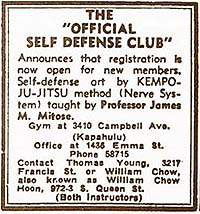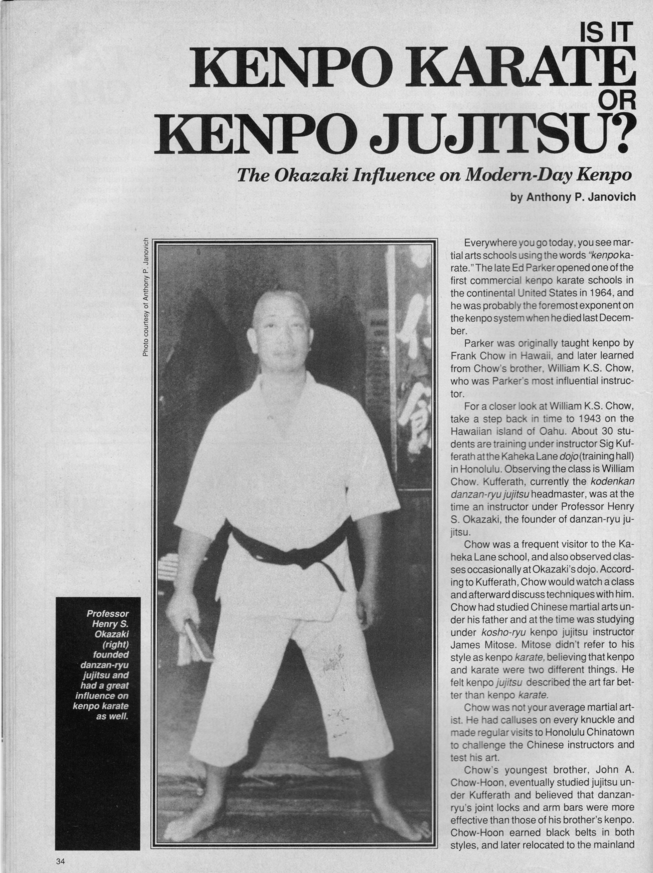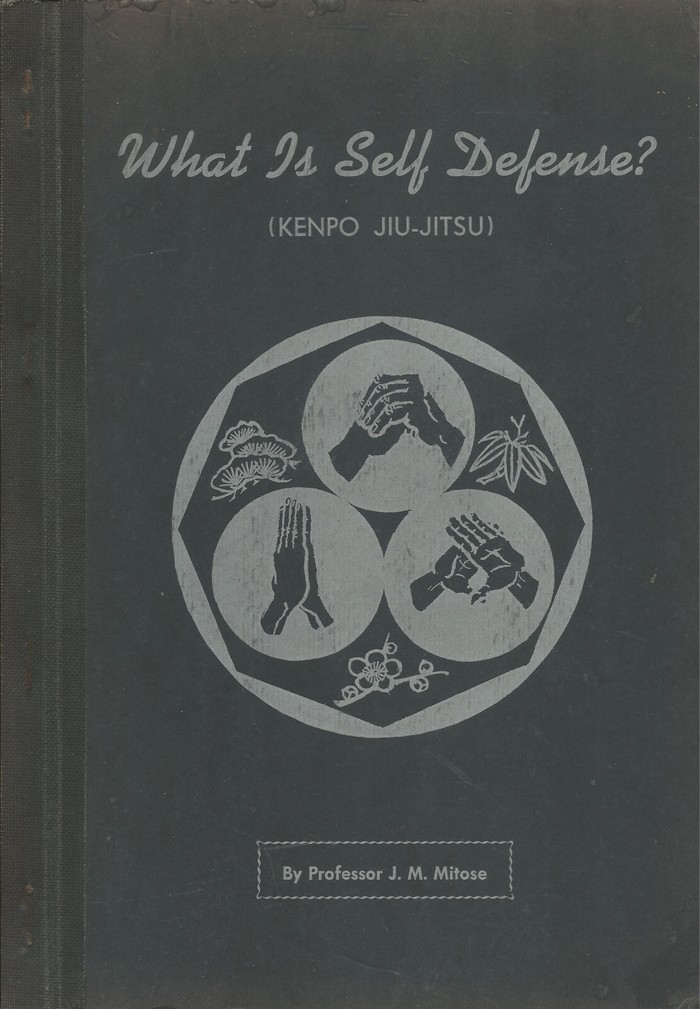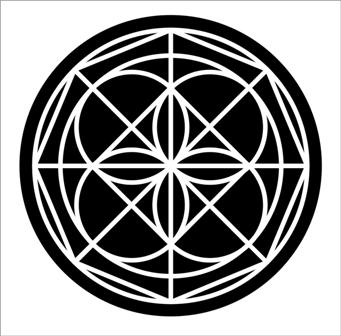|
|
|
 |
|
 |
Kenpo (or Kempo) Jiu-Jitsu
With appreciation for Kajukenbo’s Danzan-Ryu (DZR) roots and in deference to my instructor Mike Griffin, we acknowledge the jujutsu core of Kajukenbo here at the CQB Kajukenbo Club. In additional to DZR, Mike Griffin taught techniques from Hakko-Ryu, Jun Fan / JKD Grappling, BJJ, and even Defendo/Combato – which he personally learned from Bill Underwood. Bill Underwood was trained by the esteemed Yukio Tani.
We identify our core jujutsu principles by the name James Mitose used in his controversial book “WHAT IS SELF-DEFENSE? (Kenpo Jiu-Jitsu).”
‘In 1947, Mitose wrote his first book, entitled “What Is Self-Defense (Kempo Jiu-Jitsu)”. As English was not Mitose’s first language, he must have had considerable assistance from his students, many of whom appear in the book. It is said that Arthur Keawe had a major role in editing the book. Although the book was written in 1947, it was not published until 1953, under the revised title “What Is Self-Defense (Kenpo Jiu-Jitsu)”. There were actually two versions of the book. The covers and introductory sections of the books differed. Mitose did not use the term “Kenpo Karate”. It is believed that this term was first used by William H. Chow. Mitose began to teach “Kempo Jiu-Jitsu”‘ in Honolulu in 1942 — The Hawaii Karate Seinenkai
So, while some Kajukenbo schools stress the kenpo in the training (even calling it “Kajukenbo Karate” or “Kajukenbo Kenpo”, which is redundant), we focus on the jujutsu aspect and call it “Kajukenbo Self Defense”. This is one reason why our Kajukenbo does not look the same as most Kajukenbo ‘karate’ schools. We are a “kenpo jujutsu” school instead of a “kenpo karate” class. Some Kajukenbo schools have changed the name of the style they teach to represent these changes. Instead, I have kept the Kajukenbo name and “pointed the jujutsu out” to give it proper credit and recognition.
To that end, we sometimes use the “universal” kenpo symbol as our jujutsu emblem. This represents angles of movement, compound circles, escala (lines of attack), small circle principles and more.
“Jujutsu is a Japanese martial art and a method of close combat for defeating an armed and armored opponent in which one uses no weapon or only a short weapon. The word jujutsu can be spelled as ju-jitsu/jujitsu, ju-jutsu.
“Jū” can be translated to mean “gentle, soft, supple, flexible, pliable, or yielding.” “Jutsu” can be translated to mean “art” or “technique” and represents manipulating the opponent’s force against himself rather than confronting it with one’s own force. Jujutsu developed among the samurai of feudal Japan as a method for defeating an armed and armored opponent in which one uses no weapon, or only a short weapon. Because striking against an armored opponent proved ineffective, practitioners learned that the most efficient methods for neutralizing an enemy took the form of pins, joint locks, and throws. These techniques were developed around the principle of using an attacker’s energy against him, rather than directly opposing it.
There are many variations of the art, which leads to a diversity of approaches. Jujutsu schools (ryū) may utilize all forms of grappling techniques to some degree (i.e. throwing, trapping, joint locks, holds, gouging, biting, disengagements, striking, and kicking). In addition to jujutsu, many schools teach the use of weapons.
Today, jujutsu is practiced in both traditional and modern sport forms. Derived sport forms include the Olympic sport and martial art of judo, which was developed by Kanō Jigorō in the late 19th century from several traditional styles of jujutsu, and Brazilian jiu-jitsu, which was in turn derived from earlier (pre–World War II) versions of Kodokan judo.” — Wikipedia
The complete curriculum of our jujutsu techniques is taught by the time a student is ready to test for a black belt in the CQB Kajukenbo system but can also be taught as a smaller, yet complete system.
Our jujutsu techniques are borrowed from many systems such as DZR, Hakko-ryu, Sei Fu Ryu aikijujutsu and Fusen-ryu. The vast majority of these techniques are embedded throughout the standard CQB Kajukenbo system as a part of “transitional” movements. Our Kenpo Jiu-jitsu is not a koryū system and is considered to be a gendai budo / shinbudo style.
I owe Mike Griffin for most of my training, and the majority of my jujutsu knowledge is no exception. Mike added his considerable ju-jitsu expertise into our Kajukenbo training and as always, I am very lucky to have had the opportunity to train with him. Being from the Sid Asuncion “KenKaBo” line it would have been easy for Mike to simply train us all to be strikers, but Mike Griffin recognized the need for grappling long before it was cool to do so. Mike was an early adopter of Larry Hartsell‘s Jun Fan/JKD Grappling methods and was also the first instructor in the St. Louis region (that I am aware of) to adopt training in Gracie Jiu-Jitsu(tm).
Kenpo Jiu-Jitsu is our Kajukenbo locks, throws, counters, ne-waza and the like which can be taught separately without much of the “brutality” or “overkill” which Kajukenbo is generally known for. It is our same streamlined, simplified techniques without most of our “punch me in the face!” which makes it more suitable for “less hard core” training classes like self-defense seminars. You could think of it as a “lite” version of the CQB Kajukenbo system.
Requirements include, but are not limited to:
The “Three Rules of Locking”: Always strike & distract (before, during & after), Never chase a lock & Never force a lock
|
Standing Locks & attacks 1 to 18 (series 1) |
Standing Locks & attacks 19 to 27 (series 3)* |
|
1) Outside wrist lock |
19) Hammer lock come-along |
|
2) Uppercut & elbow lock |
20) Full nelson |
| 3) roll over to straight arm bar |
21) Half-nelson take-down |
|
4) Shotgun wrist bend |
22) Knee-bar take-downs |
|
5) Wishbone |
23) Thumb-bar series |
|
6) Goose-neck come-along |
24) Guillotine (traditional) |
|
7) Palm-up armbar |
25) Guillotine (Kaju) |
|
8) Blade wristlock |
26) Lubud hip block to arm bar |
| 9) S-Lock |
27) Face / jaw lock to neck crank |
|
Standing Locks & attacks 10 to 18 (series 2) |
Standing Locks & attacks 28 to 36 (series 4) |
|
10) Palm-up shoulder lock |
28) Wedge lock to shoulder throw |
|
11) Hearty handshake |
29) Reverse Guillotine to chest spike |
|
12) Finger lock series |
30) Limb destruction to Harai Goshi |
|
13) One-armed Bandit |
31) Brachial stun to Tsuri Komi Goshi |
| 14) Elbow Cradle |
32) Cross-lapel strangle |
|
15) Elbow break & throw |
33) Sliding lapel strangle |
|
16) Palm down Arm drag |
34) Rear naked strangle |
| 17) Wrist / hand Transition series |
35) Cobra strangle |
| 18) Thumb grab come-along |
36) Cross-arm strangle |
Kenpo Jiu-Jitsu also includes:
The complete throw list, including rolls and break-falls
Hip throws, shoulder throws, belt throws, take-downs & pickups, sacrifices, etc.
such as Ura Nage, Morote Gari, Tomoe Nage, Uki Waza, Yoko Wakare, Sumi Gaeshi, Kata Garuma, O Goshi, Obi Goshi, Suki Nage, Uchi Momo Harai (“uchi mata”), Seoi Nage, Yoko Guruma
The complete pin & time hold list, including escapes
Mount, Guard, Side Control, Scarf hold, twisting arm control, flag pole, etc.
The complete ground submission list, including counters
Arm bars, chokes, strangles, ankle & wrist locks, etc.
The complete grab defense list, done standing and on ground as applicable
Same-side, cross arm, headlocks, choke defenses, bear hug defenses, etc.
All combination arts, including punch defenses, throw counters, weapon disarms, etc.
Hip throw reversals, spearing, elbow cover, zoning, sacrifice reversals, etc.
Pummeling & Randori
Clinches, grips and positions against resistance. Throws and counters are added.
The complete yawara/kubotan program (“Pocket sticks”)
The complete counter series to the standing locks
I owe a lot of gratitude to many teachers, progenitors and training partners over the years, including but not limited to:
Danzan-ryu: via Shihan Joe Holck and Uncle Frank Ordonez, co-founders of the Kajukenbo system. Enough said? Mahalo nui loa!
Hakko-ryu: via Mike Griffin, who taught me almost everything I know. I can never repay that or him. Thank you, sir.
Sei Fu Ryu aikijujutsu: via Sensei John Rentschler, a training partner and friend with whom I got to spend many hours trading and testing techniques. Thank you, Sensei.
Fusen-ryu: Yukio Tani > Bill Underwood’s Defendo & Combato > Mike Griffin, thank you all.
* Although we primarily use English in class, Japanese names are provided occasionally to ease explanation.
For a little more history, check out the partial article reprinted here: Black Belt Magazine (July 1991): Is it Kenpo Karate or Kenpo Jujutsu ?
You may also click on the images below to get a look. I am posting images of the article because it is over 20 years old and I believe it falls under non-profit educational use.
I do not claim any rights to this article and I recommend that you contact Black Belt Magazine for your own copy of the issue and/or article.
Some Articles to consider:
The Life of James Mitose: Kosho-Ryu Kenpo’s Founder
Hawaii Karate Seinenkai Salutes James Mitose
Kenpo JiuJitsu—The Ultimate in Self-Defense
Comparing “OKINAWA KEMPO: KARATE-JUTSU on KUMITE” & “What is Self Defense (Kempo Jiu Jitsu)”
“Is it Kenpo Karate or Kenpo Jujitsu” – Black Belt Magazine: July 1991, page 34





